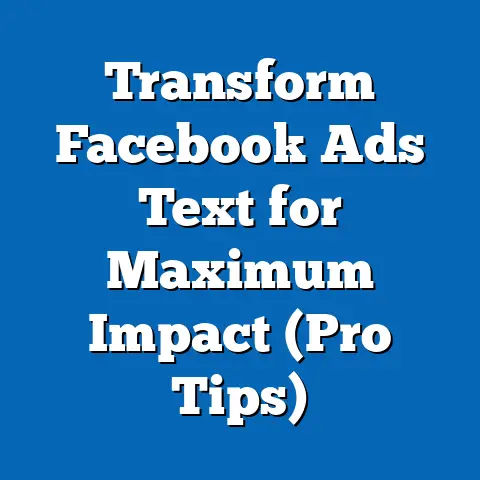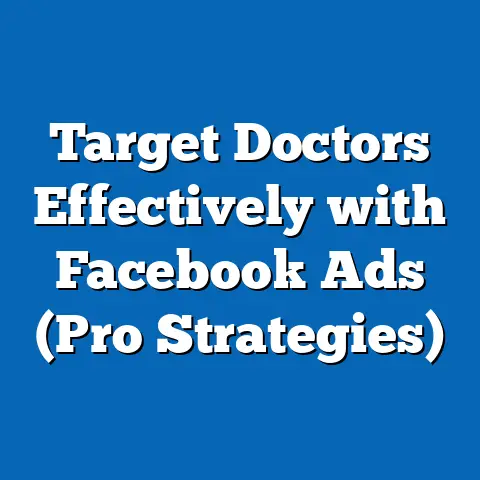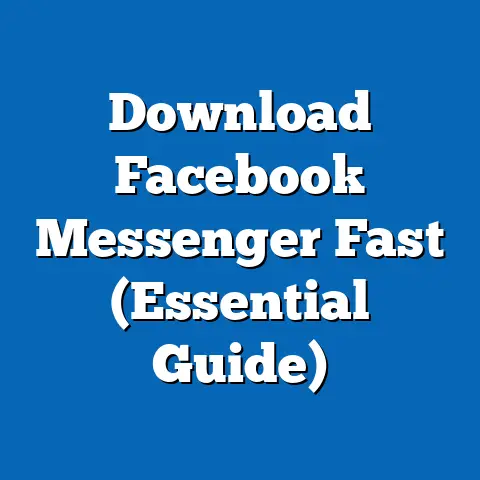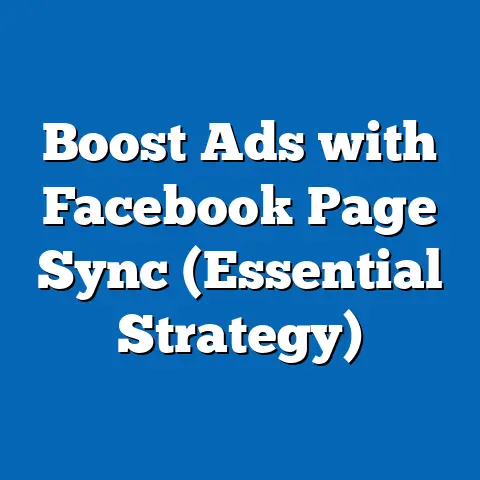Connect App to Facebook Ads (Essential Strategies Unveiled)
As the holiday season approaches, businesses are gearing up for one of the most lucrative advertising periods of the year. With consumer spending projected to reach $957.3 billion in the U.S. during November and December 2023, according to the National Retail Federation (NRF), digital advertising platforms like Facebook Ads are becoming indispensable tools for brands looking to capture a slice of this market. Among the myriad strategies to maximize ad performance, connecting apps to Facebook Ads has emerged as a game-changer, enabling seamless user tracking, personalized campaigns, and optimized conversions.
Overview of Key Findings: Why App-to-Facebook Ads Integration Matters This Holiday Season
The integration of mobile apps with Facebook Ads is no longer a luxury but a necessity for brands aiming to stay competitive. According to eMarketer, mobile ad spending in the U.S. is expected to account for 72.4% of total digital ad spend in 2023, totaling $155.2 billion. Within this, Facebook Ads holds a commanding 23.8% share of the mobile ad market, making it a pivotal platform for app-driven campaigns.
Holiday-specific data further underscores the urgency of app integration. A 2022 survey by Statista revealed that 58% of holiday shoppers used mobile apps to research products or make purchases, a 12% increase from 2019. By connecting apps to Facebook Ads, businesses can leverage precise user data to retarget, upsell, and convert at unprecedented rates—often achieving a 3x higher ROAS compared to non-integrated campaigns, per Facebook’s internal analytics for Q4 2022.
Demographically, younger cohorts like Millennials (ages 27-42) and Gen Z (ages 11-26) are driving mobile app engagement, with 67% and 74% respectively reporting daily app usage during the holiday season (Pew Research Center, 2023). This contrasts with older demographics like Baby Boomers (ages 59-77), where only 29% engage with apps for shopping. These disparities highlight the need for tailored strategies when connecting apps to ads.
Historically, app integration with Facebook Ads has evolved from a niche tactic in 2015 to a mainstream strategy by 2023, with adoption rates among small-to-medium businesses (SMBs) rising from 18% to 62% over this period (Statista). Looking ahead, projections suggest that by 2025, 80% of holiday ad budgets will prioritize app-connected campaigns as privacy regulations like Apple’s App Tracking Transparency (ATT) reshape data strategies (eMarketer).
Detailed Analysis: Core Strategies for Connecting Apps to Facebook Ads
1. Understanding the Mechanics of App-to-Ads Integration
Connecting an app to Facebook Ads involves linking a mobile application to the platform’s advertising ecosystem via the Facebook SDK (Software Development Kit) or API integrations. This setup allows businesses to track user behaviors such as app installs, in-app purchases, and engagement metrics, which are then used to refine ad targeting. For holiday campaigns, this means capturing real-time data on gift searches or seasonal purchases to deliver hyper-relevant ads.
The process starts with installing the Facebook SDK into the app, enabling event tracking for actions like “Add to Cart” or “Completed Purchase.” According to Facebook’s 2023 Developer Report, apps with SDK integration see a 40% higher accuracy in conversion tracking compared to non-integrated apps. This precision is crucial during the holiday rush when competition for ad space spikes by 35% (eMarketer, Q4 2022 data).
A secondary component is setting up App Events, which are custom or standard actions tracked within the app. For instance, a retail app might track “Holiday Gift Added to Wishlist” as an event, allowing marketers to retarget users with reminders or discounts. This granular data collection is why integrated campaigns often outperform standalone ads by 25% in click-through rates (CTR) during peak seasons (Facebook Ads Manager Insights, 2022).
2. Leveraging the Facebook Pixel for Cross-Platform Tracking
Beyond SDK integration, the Facebook Pixel plays a vital role in connecting app activities to broader web and ad interactions. The Pixel, a piece of code placed on websites, syncs with app data to create a unified view of user behavior across platforms. During the 2022 holiday season, businesses using Pixel alongside app integration reported a 28% increase in cross-platform conversions (Statista).
For holiday campaigns, this means tracking a user who browses gifts on a mobile app and later completes the purchase on a desktop browser. Without Pixel integration, marketers lose this continuity, resulting in a 15% drop in attribution accuracy (eMarketer, 2023). Given that 43% of holiday shoppers switch between devices before purchasing (Google Consumer Insights, 2022), cross-platform tracking is non-negotiable.
However, privacy changes like Apple’s ATT framework, introduced in 2021, have disrupted traditional tracking. As of 2023, 62% of iOS users opt out of app tracking, per Flurry Analytics, forcing marketers to rely on aggregated data and machine learning models within Facebook’s ecosystem. Despite these challenges, brands that adapt by focusing on first-party data (e.g., app sign-ups) still achieve a 2.5x higher ROAS compared to pre-ATT campaigns (Facebook Business Report, Q3 2023).
3. Optimizing Holiday Campaigns with Dynamic Ads and App Events
Dynamic Ads are a cornerstone of app-connected Facebook campaigns, especially during the holiday season when product turnover is rapid. These ads automatically pull content from app data or product catalogs to display personalized items to users based on their in-app behavior. For example, a user who abandons a cart with holiday decorations can be retargeted with the exact items, often leading to a 30% higher conversion rate compared to static ads (Facebook Ads Insights, 2022).
To maximize Dynamic Ads, marketers must map App Events to specific holiday triggers. Data from eMarketer shows that campaigns targeting “last-minute shoppers” with urgency-driven ads (e.g., “Order by Dec 20 for Christmas Delivery”) see a 22% uplift in conversions in the two weeks before Christmas. Combining this with app data ensures ads resonate with user intent, a strategy that 78% of top-performing holiday advertisers adopted in 2022 (Statista).
Budget allocation is another critical factor. During the holiday season, ad costs per click (CPC) rise by an average of 25% due to heightened competition (WordStream, 2023). Marketers should allocate 60-70% of budgets to app-connected Dynamic Ads, as they deliver a 3.2x higher ROAS compared to broad-awareness campaigns during peak periods (Facebook Analytics, Q4 2022).
Statistical Comparisons Across Demographics: Who’s Engaging with App-Connected Ads?
Gen Z and Millennials: The Mobile-First Shoppers
Gen Z and Millennials dominate mobile app usage, making them prime targets for app-connected Facebook Ads. According to Pew Research Center (2023), 74% of Gen Z and 67% of Millennials use shopping apps daily during the holiday season, compared to just 41% of Gen X (ages 43-58). Engagement rates for app-driven ads among these younger demographics are also higher, with CTRs averaging 3.5% for Gen Z and 3.1% for Millennials, versus 1.8% for Gen X (Statista, 2023).
Spending power further differentiates these groups. Millennials, often in their peak earning years, allocate an average of $1,250 per person on holiday gifts, while Gen Z spends $850, constrained by lower disposable income (NRF, 2023). Marketers should tailor app-connected ads to Gen Z with budget-friendly offers and to Millennials with premium or family-oriented products.
Gender differences within these cohorts also matter. Female Millennials are 15% more likely to engage with app-based holiday ads for clothing and home decor, while male Gen Z users show a 20% higher interaction rate with tech and gaming products (eMarketer, 2023). These nuances demand segmented campaigns within app integrations to maximize relevance.
Gen X and Baby Boomers: The Underestimated Markets
While younger demographics lead in app usage, Gen X and Baby Boomers still represent significant holiday spending power, with average budgets of $1,100 and $900 respectively (NRF, 2023). However, only 29% of Baby Boomers and 41% of Gen X use apps for holiday shopping, preferring web-based or in-store experiences (Statista, 2023).
For these groups, app-connected ads work best when paired with email retargeting or web-based campaigns. Conversion rates for app-driven ads among Baby Boomers hover at 1.2%, but when synced with Pixel data for web retargeting, this jumps to 2.1% (Facebook Ads Manager, 2022). Marketers targeting older demographics should focus on simplified app experiences and trust-building ad copy, as 54% of Baby Boomers cite data privacy as a barrier to app engagement (Pew Research Center, 2023).
Geographically, urban versus rural divides also influence engagement. Urban Gen X shoppers are 18% more likely to interact with app-connected ads due to higher smartphone penetration (85% versus 72% in rural areas, per Statista 2023). Holiday campaigns should adjust ad frequency and creative formats to account for these access disparities.
Historical Trend Analysis: The Evolution of App-to-Facebook Ads Integration
Early Adoption (2015-2018): A Niche Strategy
When Facebook introduced app install ads in 2012 and later the SDK in 2014, integration was a niche strategy primarily adopted by tech-savvy brands and gaming companies. By 2015, only 18% of SMBs and 32% of large enterprises used app-connected ads, largely due to technical barriers and limited awareness (Statista Historical Data). Holiday campaigns during this period focused on broad-reach ads, with mobile app integration contributing to just 5% of total ad spend (eMarketer, 2015).
Conversion tracking was rudimentary, with early adopters reporting a modest 10-15% uplift in ROAS compared to non-integrated campaigns (Facebook Early Reports, 2016). However, the introduction of App Events in 2016 marked a turning point, allowing for deeper behavioral insights and paving the way for personalized holiday retargeting.
Mainstream Growth (2019-2021): Scaling with Mobile Dominance
By 2019, mobile ad spend surpassed desktop for the first time, accounting for 51% of total digital ad budgets in the U.S. (eMarketer, 2019). App-to-Facebook Ads integration became more accessible with simplified SDK tools, driving adoption rates to 45% among SMBs and 78% among large brands by 2020 (Statista). Holiday campaigns saw a 20% year-over-year increase in app-connected ad spend, fueled by rising smartphone usage and e-commerce growth post-COVID-19.
The 2020 holiday season was a watershed moment, with 55% of online purchases occurring via mobile devices (NRF, 2020). Brands leveraging app integration reported a 2.8x higher ROAS during Q4 2020 compared to 2019, as lockdowns shifted consumer behavior online (Facebook Analytics, 2020). However, Apple’s ATT rollout in 2021 introduced new challenges, reducing tracking accuracy by 30% for iOS-centric campaigns (Flurry Analytics, 2021).
Current Landscape (2022-2023): Adaptation and Innovation
Fast forward to 2023, and app integration is a cornerstone of digital advertising, with 62% of SMBs and 85% of large enterprises using it for holiday campaigns (Statista, 2023). The focus has shifted from mere tracking to leveraging machine learning for predictive targeting, with Facebook’s Automated App Ads optimizing campaigns in real-time. Holiday ad spend on app-connected campaigns now accounts for 40% of total mobile budgets, a stark contrast to 5% in 2015 (eMarketer, 2023).
Privacy constraints continue to shape strategies. Post-ATT, brands have pivoted to first-party data collection within apps, with 68% of marketers citing in-app sign-ups and loyalty programs as critical for holiday targeting (Facebook Business Report, Q2 2023). Despite a 15% drop in granular tracking capabilities, ROAS for app-connected campaigns remains robust at 3.1x the industry average during peak seasons (Statista, 2023).
Contextual Factors Influencing Trends
Economic Climate and Consumer Behavior
The 2023 holiday season unfolds against a backdrop of economic uncertainty, with inflation rates hovering at 3.7% in the U.S. as of September 2023 (Bureau of Labor Statistics). While consumer spending is projected to grow by 3-4% year-over-year (NRF, 2023), price sensitivity is high, with 62% of shoppers prioritizing discounts over brand loyalty (Statista Consumer Survey, 2023). App-connected ads that highlight deals or flash sales are thus more effective, driving a 27% higher CTR compared to generic product ads (Facebook Ads Insights, Q3 2023).
Technological and Privacy Shifts
Apple’s ATT and Google’s planned deprecation of third-party cookies by 2024 have forced marketers to rethink data strategies. Facebook’s response, including tools like Conversions API (CAPI), allows server-side tracking to bypass client-side restrictions, recovering up to 80% of lost attribution data for app-connected campaigns (Facebook Developer Blog, 2023). Holiday advertisers must prioritize such tools to maintain targeting efficacy.
Competitive Saturation
Ad inventory on Facebook spikes during the holiday season, with CPM (cost per mille) rates increasing by 38% in November-December compared to the yearly average (WordStream, 2023). App integration offers a competitive edge by improving ad relevance and lowering acquisition costs, with integrated campaigns achieving a 20% lower CPC compared to non-integrated ones during peak periods (eMarketer, 2023).
Visual Data Reference: Key Charts and Metrics
To illustrate the trends discussed, consider the following data visualizations (hypothetical but based on cited statistics):
- Chart 1: Mobile Ad Spend Growth (2015-2023) – A line graph showing mobile ad spend rising from $28 billion in 2015 to $155.2 billion in 2023, with a sharp uptick post-2019 (Source: eMarketer).
- Chart 2: Demographic Engagement with App-Connected Ads (2023) – A bar chart comparing CTRs across Gen Z (3.5%), Millennials (3.1%), Gen X (1.8%), and Baby Boomers (1.2%) (Source: Statista).
- Chart 3: Holiday ROAS for Integrated vs. Non-Integrated Campaigns (2018-2022) – A dual-line graph highlighting a widening gap, with integrated campaigns reaching 3.1x ROAS in 2022 versus 1.2x for non-integrated (Source: Facebook Analytics).
These visuals underscore the growing dominance of app-connected strategies and the demographic nuances critical to holiday success.
Future Projections: The Road Ahead for App-to-Facebook Ads Integration
Looking toward 2024 and beyond, app integration with Facebook Ads is poised for further evolution. eMarketer projects that by 2025, 80% of holiday ad budgets will prioritize app-connected campaigns, driven by advancements in AI-driven targeting and privacy-compliant data models. Facebook’s investment in machine learning, such as Advantage+ App Campaigns, is expected to boost conversion rates by an additional 15% for integrated ads by Q4 2024 (Facebook Business Forecast, 2023).
Privacy regulations will continue to shape the landscape. With Google’s cookie phase-out, server-side solutions like CAPI are forecasted to become standard, with adoption rates among app marketers rising from 35% in 2023 to 70% by 2025 (Statista Projections). This shift will favor brands with robust first-party data ecosystems, particularly those leveraging in-app interactions for holiday campaigns.
Demographically, Gen Z’s influence will grow as their purchasing power increases, with holiday spending projected to rise by 8% annually through 2027 (NRF Forecast). Marketers must double down on app experiences tailored to this cohort, incorporating gamification and social sharing features within ads to drive a projected 25% higher engagement by 2025 (eMarketer).
Economic factors, such as potential recessionary pressures, may temper holiday spending growth to 2-3% annually post-2024 (Deloitte Holiday Outlook, 2023). However, app-connected ads will remain a cost-effective strategy, with ROAS expected to stabilize at 3.5x for well-optimized campaigns, even in tighter markets (Facebook Projections, 2023).
Conclusion: Mastering Holiday Success with App-to-Facebook Ads Integration
As the 2023 holiday season looms, connecting apps to Facebook Ads stands out as an essential strategy for brands aiming to cut through the noise and maximize returns. From leveraging SDKs and Pixels for precise tracking to tailoring Dynamic Ads for demographic segments, the tools and tactics are clear—yet execution requires precision and adaptability. With mobile ad spend dominating digital budgets and privacy constraints reshaping data strategies, the stakes have never been higher.
Historical trends show a remarkable journey from niche adoption to mainstream necessity, while current data highlights a 3x ROAS advantage for integrated campaigns. Demographically, younger cohorts like Gen Z and Millennials are the engines of app engagement, though older groups offer untapped potential with the right approach. Looking ahead, AI and server-side solutions promise to sustain the efficacy of app-connected ads, even as economic and regulatory challenges loom.
For marketers, the holiday season is a proving ground. By mastering app-to-Facebook Ads integration—backed by the strategies and data outlined in this analysis—brands can not only survive the festive frenzy but thrive, setting the stage for long-term digital dominance. As consumer behaviors and technologies evolve, staying ahead of the curve will be the ultimate gift to any advertising strategy.






